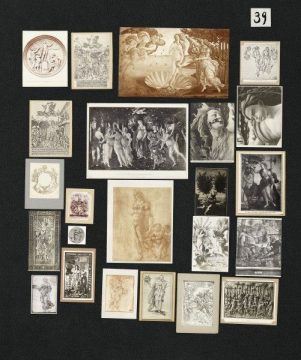Lucy Ives at Art in America:
 It was only in the second volume of Warburg’s Gesammelte Schriften (Collected Writings), published in 2000, that the glass negatives created in 1929 were used to publish fragmentary pictorial evidence of the “Bilderatlas Mnemosyne.” Editors Martin Warnke and Claudia Brink produced black-and-white images from the negatives, printing them at a reduced size that tended to obscure their details. They also left off additional commentary, given the lack of extant captioning by Warburg himself. This publication was in no small part encouraged by the resurgence of interest in the works of Walter Benjamin (1892–1940), whose theories of media and history had come to seem prescient, particularly in the Anglophone world, with the 1969 Illuminations, edited and introduced by Hannah Arendt and subsequently popularized by John Berger in his 1972 TV series and book, Ways of Seeing. (While Warburg was only peripherally aware of Benjamin during his lifetime, Benjamin sent Warburg a copy of his thesis on Baroque Trauerspiel, or tragic drama, which cited Warburg.) Like Benjamin, who often engaged in leaps of thought and argument by way of metaphorical image rather than logical deduction, Warburg was concerned with Zwischenräume, the spaces in between, as well as something he termed Denkraum, or room for thought.
It was only in the second volume of Warburg’s Gesammelte Schriften (Collected Writings), published in 2000, that the glass negatives created in 1929 were used to publish fragmentary pictorial evidence of the “Bilderatlas Mnemosyne.” Editors Martin Warnke and Claudia Brink produced black-and-white images from the negatives, printing them at a reduced size that tended to obscure their details. They also left off additional commentary, given the lack of extant captioning by Warburg himself. This publication was in no small part encouraged by the resurgence of interest in the works of Walter Benjamin (1892–1940), whose theories of media and history had come to seem prescient, particularly in the Anglophone world, with the 1969 Illuminations, edited and introduced by Hannah Arendt and subsequently popularized by John Berger in his 1972 TV series and book, Ways of Seeing. (While Warburg was only peripherally aware of Benjamin during his lifetime, Benjamin sent Warburg a copy of his thesis on Baroque Trauerspiel, or tragic drama, which cited Warburg.) Like Benjamin, who often engaged in leaps of thought and argument by way of metaphorical image rather than logical deduction, Warburg was concerned with Zwischenräume, the spaces in between, as well as something he termed Denkraum, or room for thought.
more here.
